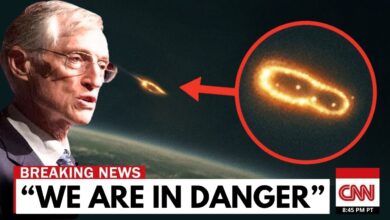“This Is Going To Hurt!” James Webb Telescope just Found a 400 Million Solar Mass DORMANT Black Hole

Imagine a cosmic giant — a black hole with a mass 400 million times that of our Sun. This is the groundbreaking discovery recently made by the James Webb Space Telescope, opening an entirely new chapter in our understanding of black hole formation and the evolution of galaxies. But what makes this finding so revolutionary? What does it reveal about the early universe? And why is it shaking the very foundation of long-established theories?
Among Webb’s many astonishing discoveries is this dormant black hole — a massive, silent object not feeding on matter, not glowing, quietly hidden in a small galaxy from the universe’s earliest days. Detecting it was like spotting a shadow in a room full of light — a powerful demonstration of Webb’s precision and its unique ability to peer into the darkest corners of the cosmos.
Normally, black holes reveal themselves when actively consuming matter, emitting bright radiation. But this one remained hidden. Scientists relied on faint infrared signals and spectral patterns from its host galaxy to detect its presence. These subtle fingerprints revealed a powerful gravitational pull, the unmistakable signature of a black hole — one that was completely dormant.
What truly sets this discovery apart is its scale: 400 million times the mass of the Sun. To picture that, if our Sun were the size of a marble, this black hole would be a sphere nearly 3 kilometers wide — a staggering difference. Even more surprising, the galaxy it’s in is relatively small, yet this black hole accounts for 40% of its entire mass. For comparison, in most galaxies today, black holes make up just 0.1% of the galaxy’s total mass.
This suggests a bold new idea: perhaps black holes formed first, and galaxies followed. It flips the long-held belief that galaxies and black holes evolved side by side. Instead, in the chaotic early universe, black holes may have been the architects of galactic structure, not just byproducts.
Traditional models paint black hole growth as slow and steady, limited by the Eddington rate — the balance between gravity pulling matter in and radiation pushing it away. But this black hole rewrites that script. Its enormous mass, formed so early after the Big Bang, suggests a more chaotic, accelerated origin. One theory is super-Eddington accretion — a cosmic feeding frenzy where a black hole rapidly devours matter far beyond the expected limit, then settles into a dormant phase.
Another, even more radical theory proposes that some black holes were born massive — forming directly from the collapse of enormous gas clouds, skipping the slow-growth phase entirely.
To explore these ideas, scientists are now running complex simulations that could completely rewrite our understanding of black hole formation.
But the implications stretch beyond black holes. This discovery challenges how we think galaxies form, how stars evolve, and how dark matter and dark energy interact across the cosmos. Perhaps most intriguingly, it suggests black holes played a leading role in shaping galaxies from the very beginning — not just quietly lurking at their centers.
When compared to other Webb discoveries, this black hole isn’t just remarkable for its size — its dormancy is what truly sets it apart. Most early-universe black holes are active and easy to spot. This silent giant, however, hints that many more dormant black holes might be out there, hidden in plain sight, waiting to be found.
If dormancy turns out to be a common phase, it could change how astronomers search for black holes entirely. It means black holes don’t just roar; they also whisper. And that changes everything.
In fact, dormant black holes might help galaxies evolve more smoothly, avoiding the violent disruptions caused by active black holes — no powerful radiation, no destructive jets. Understanding this quiet balance could help explain the history of galaxies like our own Milky Way.
Interestingly, this isn’t the first dormant black hole we’ve found. In our galactic neighborhood, the Gaia BH3 black hole was discovered by the European Space Agency’s Gaia mission — with a mass about 33 times that of the Sun, also silent, without a companion star to feed on. But the one Webb discovered is a different beast entirely: far more massive, far older, forming when the universe was less than a billion years old.
By contrast, Gaia BH3 sits in a mature galaxy nearly 13.8 billion years after the Big Bang. The contrast is stunning. And it forces astronomers to ask: How could something so massive form so fast? What conditions made it possible?
These are the questions that now drive scientists to dig deeper into the cosmic past. Because a black hole this big is hard to miss — just like that subscribe button. Hit it now… before this discovery pulls you in.








